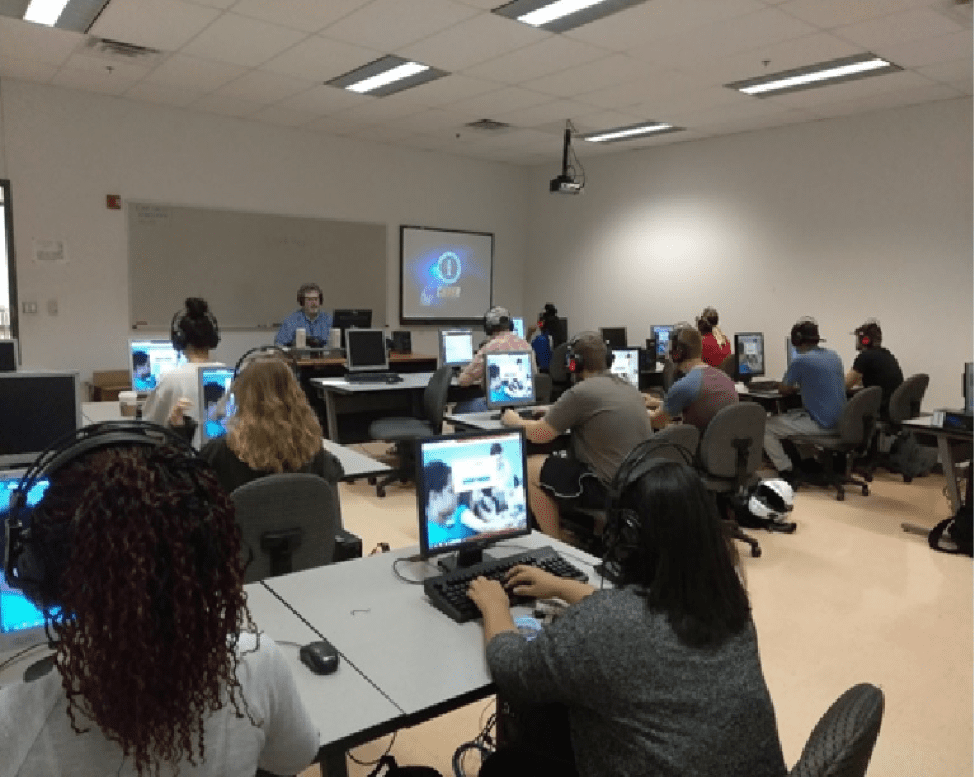CCN Focus: “IT from punched cards to the speed of light” – J.B. (JB) Groves III of WCJC
As a part of the National Convergence Technology Center (CTC) featured blogs, we would like to introduce to you some of our professors and instructors in the Convergence College Network (CCN) community. The CCN is a select cohort of community colleges and universities from across the country that connects IT educators with a wealth of resources to enhance their programs. In this week’s Q&A blog, we’re featuring J.B. Groves, III, Instructor of Computer Science at Wharton County Junior College, Wharton, Texas. 
What do you teach? I currently teach Optical Wireless Communications otherwise known as LiFi (Light Fidelity), Millimeter Wave/ 5G NR (New Radio), PC Maintenance, Networking, Mobile/Cyber Security, Fiber Optics Systems Installation, and MS Office (any version). I have twenty plus certifications in what I teach.
How long have you been a teacher? I have been a teacher for over twenty years at WCJC. I was a trainer in the industry due to systems migrations and support for over twenty years.
Did you have a job in the industry prior to teaching? Yes…many….In 1975 after being bit (literary pun) by the computer bug and learning how to program in RPG, Fortran, and COBOL on an IBM 1130 minicomputer at Wharton County Junior College, I worked six and a half years for the Prudential Insurance Company of America in Houston, Texas from 1975 to 1981. To get promoted from stock clerk I had to study the IBM manuals and pass A test to qualify to work on the IBM punch card machines and get raises in salary for every test I passed. Sound familiar?
I was promoted into the “machine room” (where the IBM mainframe resided) as a tape librarian. We handled a lot (thousands) of 2400 ft. IBM tapes. I then was promoted to computer operator which included mounting tapes on tape drive units and creating microfiche from those tapes. When the company decided to centralize operations in Jacksonville, Florida in 1981 I resigned and joined a California based company called Baker Packers with a plant in Houston which eventually regained its original name – Baker Oil Tools.
From 1981 to 1991 I worked on every enterprise class mainframe that IBM produced. The change in IBM models required a “push-pull” – push the old machine out and pull the newer and faster technology in. There was a lot of planning, hard work, and working with IBM Customer Engineers in this job for these “system migrations” and I loved it; 14-plus hour days.
In 1991 Baker Oil Tools management contracted Deloitte and Touché to “real-size” mainframe operations to an IBM AS/400 midrange computer. I was on the “BEST” Project. I traveled and worked in Mexico City and Maracaibo, Venezuela. I also worked on the North slope in Deadhorse, Alaska within the Arctic Circle deploying Windows 95 OS/ Dell platform hardware migrations for all of our districts in the lower 48. I was a single incumbent position for supporting eighty-five districts in North American Operations for seven and a half years and I traveled to just about all of them.
All good things come to an end – after nineteen wonderful years in “the patch.” I was politically motivated to leave in 1999. That’s the year I went to work for WCJC.
What sparked your interest in teaching? After 27 years in industry, I was laid off and had just completed my master’s degree in Information Technology at the University of Houston, College of Technology (I had also been working on my PhD at Texas A&M in College Station) in educational psychology. When I got laid off by Baker Hughes, I decided I would do both – a career change thanks to my ed psych training, plus transfer my IT knowledge in industry to the IT students at the college. These changes got my career started in computing at WCJC.
What is the secret to successfully teaching IT students? Understanding and remembering what the “Novice Effect” is from the 1970s.Every student that walks through your door that first day of class in that classroom is a novice. You must train the student in IT (or any field for that matter) as if this is the first time, he/she is ever seeing/doing what it is you are training them for…period…exclamation point. And here is how I convert the novice student of IT…
The Robert Mager Floor Plan of training and development:
- Tell the student or the employee how to do it…
- Show the student or employee how to do it…
- Let the student or employee do the activity (job performance) …
- Assess the student or employee’s activity (job performance) for the predicted change in behavior…
If it was done correctly go on, if it was not done correctly figure out why and go back and redo it until the activity is performed correctly.

J.B. (JB) Groves III, Instructor of Computer Science at Wharton County Junior College.
What is the biggest challenge in teaching IT? For me it is the necessary resources. I always believe you must have a robust learning environment for learning to happen. I use widgets for my training…a lot of widgets. For instance, I was asked to create a Fiber Optics Certification training program at WCJC. Thanks to Senator Robert Dole and NASA I was retrainable within Texas Workforce. I was qualified to take training in fiber optics as a part of ROV training at the Institute of Robotics. I did a Perkins proposal for a Perkins grant at WCJC to purchase the needed equipment and consumables to start the Electronics Technicians Association Certified Fiber Optic Installer training. This type of program required widgets in order to teach this type of class effectively for knowledge transfer to my students and certification-as does PC Hardware, Networking Fundamentals, LiFi…etc. I have updated my widgets in this class due to companies asking that their employees be retrained with Texas Workforce grants through our Continuing Education program-numerous times. Sometimes I go out and beat the bushes to bring fiber companies in to get their employees certified-workforce development.
And do you have a favorite class to teach? If so, why? Optical Wireless Communications – It is changing the world right now.
What is the best thing about being a teacher? The “aha!” moment when the student understands the concept.
What advice would you give an IT student that is about to graduate and enter the workforce? Review what is currently happening in IT that is real. There is a lot of noise out there. The real work is happening unbeknownst to a major segment of IT. For example, 230 towns in Africa on the Ivory Coast and neighboring countries have solar powered, Intel Sat backbone LiFi systems that connect over fifty thousand people, their clinics, community centers, and schools to the Internet. This technology is currently being deployed in the rural AIX-Provence in France-150,000 people as well as their hospitals and schools. Tonight, ask someone what they know about LiFi. See what kind of response you get. You mean Wi-Fi…no LiFi…Light Fidelity. Click here to learn more about the picture below and LiFi in Africa.
How do you keep up with the ongoing evolution of IT? I read an awful lot, research the web. I have been an SME (Subject Matter Expert) for ETA (Electronics Technicians Association) for over fifteen years in twenty IT-related technological fields in which I serve on advisory boards.I also research and write proposals in order to present at NSF (National Science Foundation), HI-TEC (High Impact Technology Exchange Conference), ETA’s Ed Forum in conjunction with IWCE (International Wireless Communications Expo), and the NCPN (National Career Pathways Network) conferences and many others.I talk with my NSF colleagues about what they are doing by going to their sessions. I also go to conferences in Houston and IT training at Texas A&M in College Station.I write articles and labs that are published. Talk to a lot of people. I will attend CES (Consumer Electronics Show) again this year. I am currently taking an NSF funded cohort training in Integrating IT and Employability Skills from the Necessary Skills Now Network.
The main thing to remember is the part of Sam Houston’s family crest (which is the University of Houston’s crest) the is the winged hour glass. Time passes no matter what you do. Make the best use of your time…and if I make it three to four more years in my job, I will have “worked” 50 years in IT. Remember Mattress Mack of Gallery Furniture in Houston says “If you love your job, you’ll never work a day in your life.” How very, very true!

